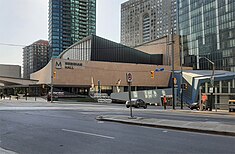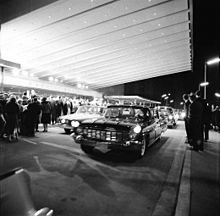
The Royal Opera House (ROH) is a historic opera house and major performing arts venue in Covent Garden, central London. The large building is often referred to as simply Covent Garden, after a previous use of the site. It is the home of The Royal Opera, The Royal Ballet, and the Orchestra of the Royal Opera House. The first theatre on the site, the Theatre Royal (1732), served primarily as a playhouse for the first hundred years of its history. In 1734, the first ballet was presented. A year later, the first season of operas, by George Frideric Handel, began. Many of his operas and oratorios were specifically written for Covent Garden and had their premieres there.

Arts Centre Melbourne, originally known as the Victorian Arts Centre and briefly called the Arts Centre, is a performing arts centre consisting of a complex of theatres and concert halls in the Melbourne Arts Precinct, located in the central Melbourne suburb of Southbank in Victoria, Australia.
The National Ballet of Canada is a Canadian ballet company that was founded in 1951 in Toronto, Ontario, with Celia Franca, the first artistic director. A company of 70 dancers with its own orchestra, the National Ballet has been led since 2022 by artistic director Hope Muir. Renowned for its diverse repertoire, the company performs traditional full-length classics, embraces contemporary work and encourages the creation of new ballets, as well as the development of Canadian dancers and choreographers.
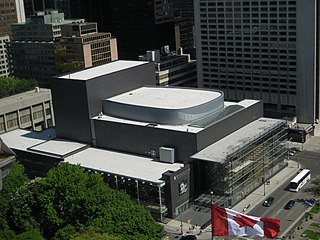
The Canadian Opera Company (COC) is an opera company in Toronto, Ontario, Canada. It is the largest opera company in Canada and one of the largest producers of opera in North America. The COC performs at the Four Seasons Centre for the Performing Arts, which was purpose-built for opera and ballet and is shared with the National Ballet of Canada. For forty years until April 2006, the COC had performed at the O'Keefe Centre.
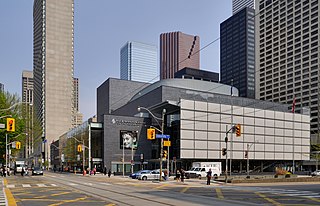
The Four Seasons Centre for the Performing Arts is a 2,071-seat theatre in Toronto, Ontario, Canada, located at the southeast corner of University Avenue and Queen Street West, across from Osgoode Hall. The land on which it is located was a gift from the Government of Ontario. It is the home of the Canadian Opera Company (COC) and the National Ballet of Canada. The building's modernist design by was created by Canadian firm Diamond and Schmitt Architects, headed by Jack Diamond. It was completed in 2006, and the interior design includes an unusual glass staircase.
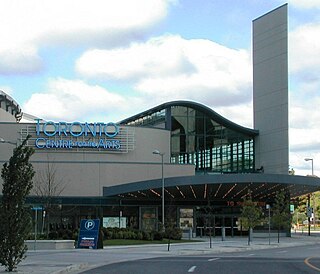
The Meridian Arts Centre is a performing arts venue in the North York district of Toronto, Ontario, Canada. It opened on October 16, 1993, as the North York Performing Arts Centre and was designed by Canadian architect Eberhard Zeidler for musicals, theatre productions and other performing arts. At opening, North York awarded management of the centre to Livent, which sold the naming rights in 1994 to Ford Motor Company of Canada. It became the Ford Centre for the Performing Arts. Later, it debranded as the Toronto Centre for the Arts.

The Queensland Performing Arts Centre is part of the Queensland Cultural Centre and is located on the corner of Melbourne Street and Grey Street in Brisbane's South Bank precinct. Opened in 1985, it includes the Lyric Theatre, Concert Hall, Playhouse and Cremorne Theatre.

The Marcus Performing Arts Center, originally the Performing Arts Center, is a performing arts center in Milwaukee, Wisconsin, United States. Managed by a non-profit organization, it is marketed as Milwaukee's premier presenter of the performing arts. It is located at 929 North Water Street, at the intersection of State Street in downtown Milwaukee, and is a dedicated War Memorial.

The Auditorium Theatre is a music and performance venue located in the Auditorium Building at 50 E. Ida B. Wells Drive in Chicago, Illinois. Inspired by the Richardsonian Romanesque Style of architect Henry Hobson Richardson, the building was designed by Dankmar Adler and Louis Sullivan and completed in 1889. The Chicago Symphony Orchestra performed in the theatre until 1904 as well as the Chicago Grand Opera Company and its successors the Chicago Opera Association and Chicago Civic Opera until its relocation to the Civic Opera House in 1929. The theater was home to the Joffrey Ballet from 1998 until 2020. It currently hosts a variety of concerts, musicals, performances, and events. Since the 1940s, it has been owned by Roosevelt University and since the 1960s it has been refurbished and managed by an independent non-profit arts organization.

Toronto is the largest city in Canada and one of the most multicultural cities in the world. Many immigrant cultures have brought their traditions languages and music to Toronto. Toronto, the capital of the province of Ontario, is a major Canadian city along Lake Ontario's northwestern shore. It's a dynamic metropolis with a core of soaring skyscrapers, all dwarfed by the iconic, free-standing CN Tower. Toronto also has many green spaces, from the orderly oval of Queen's Park to 400-acre High Park and its trails, sports facilities and zoo.

The Christchurch Town Hall, since 2007 formally known as the Christchurch Town Hall of the Performing Arts, opened in 1972, is Christchurch, New Zealand's premier performing arts centre. It is located in the central city on the banks of the Avon River overlooking Victoria Square, opposite the former location of the demolished Christchurch Convention Centre. Due to significant damage sustained during the February 2011 Christchurch earthquake, it was closed until 2019. Council staff initially recommended demolition of all but the main auditorium, but at a meeting in November 2012, councillors voted to rebuild the entire hall. In 2020, the town hall was registered as a Category I heritage building.

The Northern Alberta Jubilee Auditorium is a 4-million-cubic-foot (110,000 m3) performing arts, culture and community facility, located in Edmonton, Alberta, Canada.

Martin Marietta Center for the Performing Arts is the premier location for cultural arts and entertainment in Raleigh, North Carolina. The center consists of four unique venues, Raleigh Memorial Auditorium, Meymandi Concert Hall, A.J. Fletcher Opera Theater, and Kennedy Theatre.
Eugene O'Keefe, baptized as Owen Keeffe, was an Irish-born Canadian businessman and philanthropist, well-known in the brewing industry for his signature brews. He incorporated the O'Keefe Brewery Company of Toronto Limited in 1891.
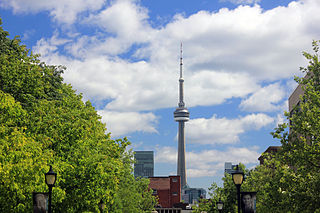
Recreation in Toronto consists of a varied selection of activities and events throughout the city year-round. Toronto boasts renowned theatre and arts communities, has a wide range of recreational public services, and offers many attractions for both residents and tourists.
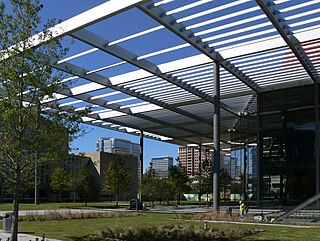
The AT&T Performing Arts Center in Dallas, Texas, preliminarily referred to as the Dallas Center for the Performing Arts, is a $354-million multi-venue center in the Dallas Arts District for performances of opera, musical theater, classic and experimental theater, ballet and other forms of dance. It opened with a dedication by city leaders on October 12, 2009.

The L Tower is a residential skyscraper in Toronto, Ontario, Canada designed by architect Daniel Libeskind. The project, which broke ground in mid-October 2009, saw many delays. One cause for delay was a stop-work order caused by safety concerns about the crane at the top of the building. The crane was also considered an eyesore for many residents. Despite the cranes, the building still won the eighth place Emporis Skyscraper Award in 2017.

The Julie Rogers Theatre is a historic performing arts theatre located on Pearl Street in downtown Beaumont, Texas. Built in 1928, the theatre was once Beaumont's City Hall and Auditorium. The capacity is approximately 1,663 seats.

The Joe R. and Teresa Lozano Long Center for the Performing Arts is a performing arts venue located along Lady Bird Lake in downtown Austin, Texas. The Long Center is the permanent home of the Austin Symphony Orchestra, Austin Opera and Ballet Austin and hosts other Austin-area performing arts organizations.
The Odeon Theatre Toronto was a movie theatre located at 20 Carlton Street in Toronto, Ontario. Designed by architect Jay English and operating between 1949 and 1973, the theatre was the Canadian flagship of Odeon Cinemas and one of Toronto's best examples of Streamline Moderne architecture.
